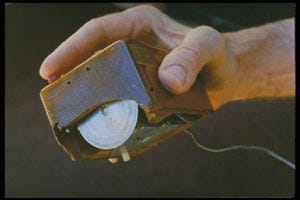Let’s talk optimization, designing your actions be as efficient as possible. We know that this is done in manufacturing; it used to be done in programming when RAM and computing power were more scarce. It is done in farming and homesteading. Joel Salatin says somewhere that if you need to walk out to the chicken coop, think about what else needs to go out there and bring it with. You want to minimize extra trips. In such concerns it makes sense. These are businesses and greater efficiency means greater profits.
But what about you, in your ordinary interactions with the world? Does it pay to take time to do things right?
How much time do you spend on a computer? Do you use it for work? Do you stare at a screen and interact with the computer? How many times per day? Ten? Fifty? It’s probably closer to thousands. If you can improve these interactions even a little bit, you will recover time and likely avoid injury and discomfort.
The mouse
The computer mouse was a neat invention. It allowed the user to interact with the computer in an intuitive way, by pointing at objects. The screen of the computer could be imagined as a desktop, with various folders. If you wanted to open a folder, you could point at it with the mouse and “open” it. For some applications, it’s a nearly perfect tool. If you are manipulating images, it’s ideal. You can just grab things and move them where they should be.
For anything requiring text entry, however, it’s a disaster, especially if you know how to type. It requires you to remove your hand from the keyboard and move it to the mouse. This takes time. Perhaps it is a little bit of time, but remember that you are likely doing this thousands of times a day. The mouse is also generally physically cumbersome. This study found a risk ratio of 4 for wrist discomfort among habitual mousers.
But what can you do? Computer interfaces require mousing, don’t they?
Keyboard shortcuts
Not always. There are such things as keyboard shortcuts. You know a few of them already, Ctrl C for copying and Ctrl V for pasting. These do not require you to move a hand from the keyboard and can make you much more efficient in all of your computer activities.
Why don’t you use them? Most people don’t know about them. If they do know about the shortcuts, they won’t take the time to learn them. There is a learning curve that can be rather steep. The perceived cost of spending half an hour learning the shortcuts is higher than the immediate cost of using the mouse. Thus, we do the same inefficient activity over and over again and our wrists hurt.
Text Editing in Vim
The text editor Vim (vi Improved) is a good example. There is no need to use a mouse while editing text. The editor has two modes, one for entering text and one for doing operations on the text. The whole keyboard is used for these commands. The learning curve is famously steep: even exiting the program takes some work!
If you climb the learning curve, at the top of the mountain you come into a clearing, a verdant meadow of ease and comfort. Once you learn the shortcuts, you’ll never want to use anything else again. You’ll be able to write much faster than anyone else. You’ll hold on to Vim until they pry it out of your cold, dead hands.
I hear that the writer of Game of Thrones still uses Wordstar, a word processor last updated in 1992. This makes sense. He’s learned the keyboard shortcuts and it’s faster than selecting text with the mouse, clicking the italic button, and returning one’s hands to the keyboard. Odd that he still doesn’t write very fast. . .
I use a Chrome extension to map Vim shortcuts into my browsing experience. I don’t need to use the mouse to navigate a web page. Aren’t you jealous?
Easy steps you can take
I’m not expecting you to adopt the nerd editor Vim or its more modern fork Neovim. It would be a good thing if you did, but what you can do is learn what the keyboard shortcuts are for your most-used software. Usually you can search for the name of your program, keyboard shortcuts, and cheatsheet. Someone will have produced a nice PDF for you.
For example, here is a cheat sheet for Google Chrome. Print it out and put it by your computer. Move the mouse farther away and do your normal web activity without it. Force yourself to use the shortcuts. Get over the hump on the learning curve and you’ll find that you are faster and that your right hand doesn’t hurt as much.
I work for Barbell Logic as a strength and nutrition coach. We’ve developed an app there to optimize online coaching. I am very pleased that there are sensible keyboard shortcuts available! It makes my daily work much faster, which leaves me more time for homesteading, reading, music, family, and writing Substack articles.






I like this analogy of climbing the mountain to get to the clearing. You can take this principle a step further with tiling window managers (also using vim keybindings) which can reduce mouse usage even more. I work as a software developer and my current set up is neovim, tmux, the chrome extension you mentioned and aerospace (a tiling window manager for Mac), meaning the mouse is rarely needed!